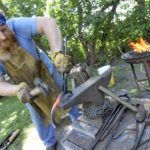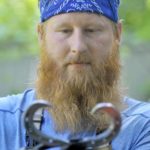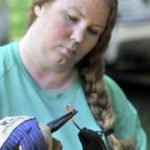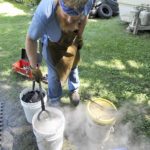Artist at the forge
In Stratford, Ty Murray is a blacksmith
-
-Messenger photo by Hans Madsen
Ty Murray, of Stratford, begins the process of making a heart from a horseshoe. He began blacksmithing when he was 9. Murray is co-owner of Boone Forks Forge along with his partner, Darcy Runestad.
-
-Messenger photo by Hans Madsen
Ty Murray, of Stratford, checks his progress as he works on making a heart from a horseshoe recently. Murray has to work carefully to make sure the two sides match up.
-
-Messenger photo by Hans Madsen
Darcy Runestad, of Stratford, uses pliers to shape a smaller piece still glowing from the forge. Not all blacksmithing work is done by hammering.
-
-Messenger photo by Hans Madsen
As the heart Ty Murray, of Stratford is working on nears completion he carefully heats the top section in his forge to complete joining the two halves. Making a heart from a horseshoe requires several heating, bending and hammering steps to complete.
-
-Messenger photo by Hans Madsen
At the completion of the heating, bending and hammering work, Ty Murray quenches the now fully formed horseshoe heart in a bucket of water. The heart still has to be polished, clear coated and a ribbon to hang it up, woven through the nail holes by his partner Darcy Runestad.
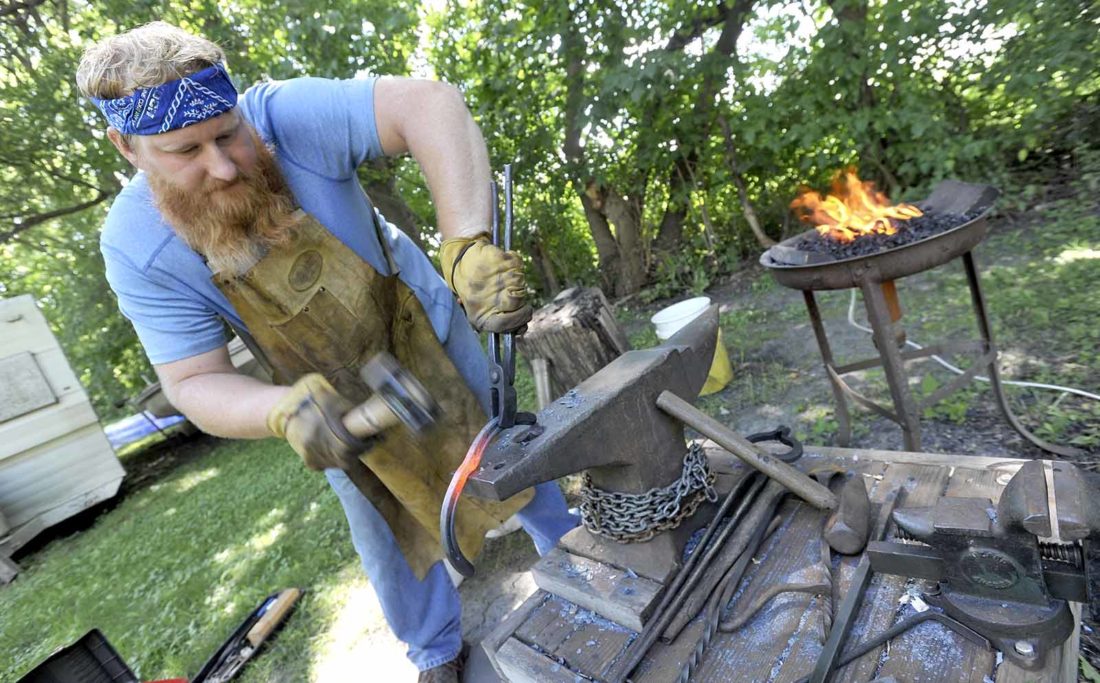
-Messenger photo by Hans Madsen
Ty Murray, of Stratford, begins the process of making a heart from a horseshoe. He began blacksmithing when he was 9. Murray is
co-owner of Boone Forks Forge along with his partner,
Darcy Runestad.
STRATFORD — Ty Murray has been hitting pieces of red hot steel with a hammer since he was about 9 years old when he was introduced to the art by his dad, Bill Murray.
It may have been a way for his dad to keep the children busy.
“Dad had a forge, he had coal, he had the anvil, he had the hammer,” Murray said. “He had everything I needed to get started. He would light the forge for us, and he had a pile of scrap steel. We just started making stuff.”
One of the first things Murray remembers making was a spit for roasting food on a fire.
He no longer has it.
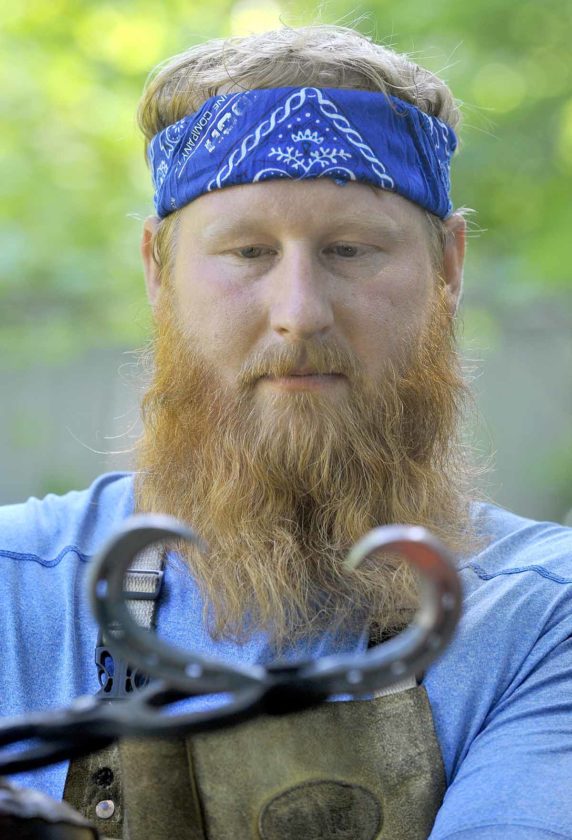
-Messenger photo by Hans Madsen
Ty Murray, of Stratford, checks his progress as he works on making a heart from a horseshoe recently. Murray has to work carefully to make sure the two sides match up.
“I have no idea where that would be,” he said.
About seven years ago, Murray, along with his partner, Darcy Runestad, went pro. They operate Boone Forks Forge together.
It took him years of working on his craft before he felt comfortable offering his creations for sale.
He, like most who start working at the forge, got into a project best left to those with lots of experience.
“I was going to make a sword,” he said. “That’s the worst thing you can start with. A sword is very complicated.”
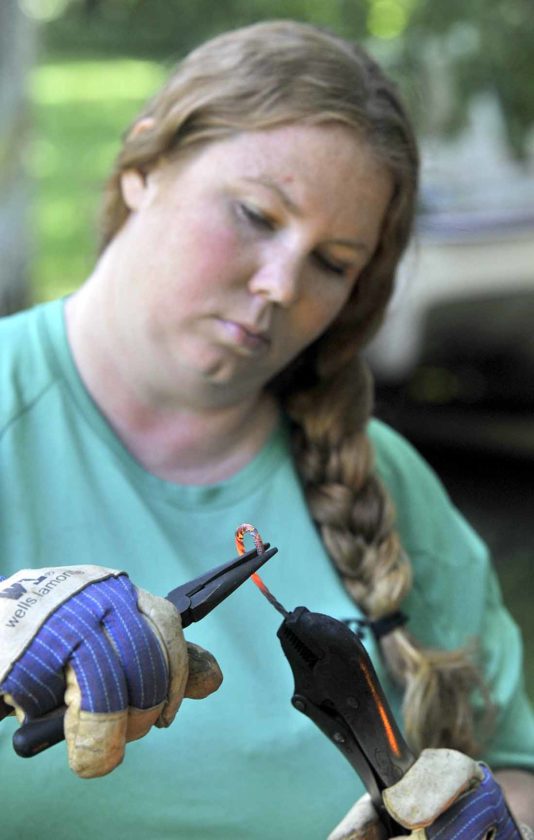
-Messenger photo by Hans Madsen
Darcy Runestad, of Stratford, uses pliers to shape a smaller piece still glowing from the forge. Not all blacksmithing work is done by hammering.
He held up a piece of steel that looked a little bit like a sword.
“This is as far as I got,” he said.
He recommends a simpler project, repeated over and over, to get going.
“Instead of a sword, I should have made a hundred leaves,” he said. “It will teach you how the steel moves with the hammer, how to get the heat right. Start simple and small.”
Even as an experienced artist, Murray is still learning.
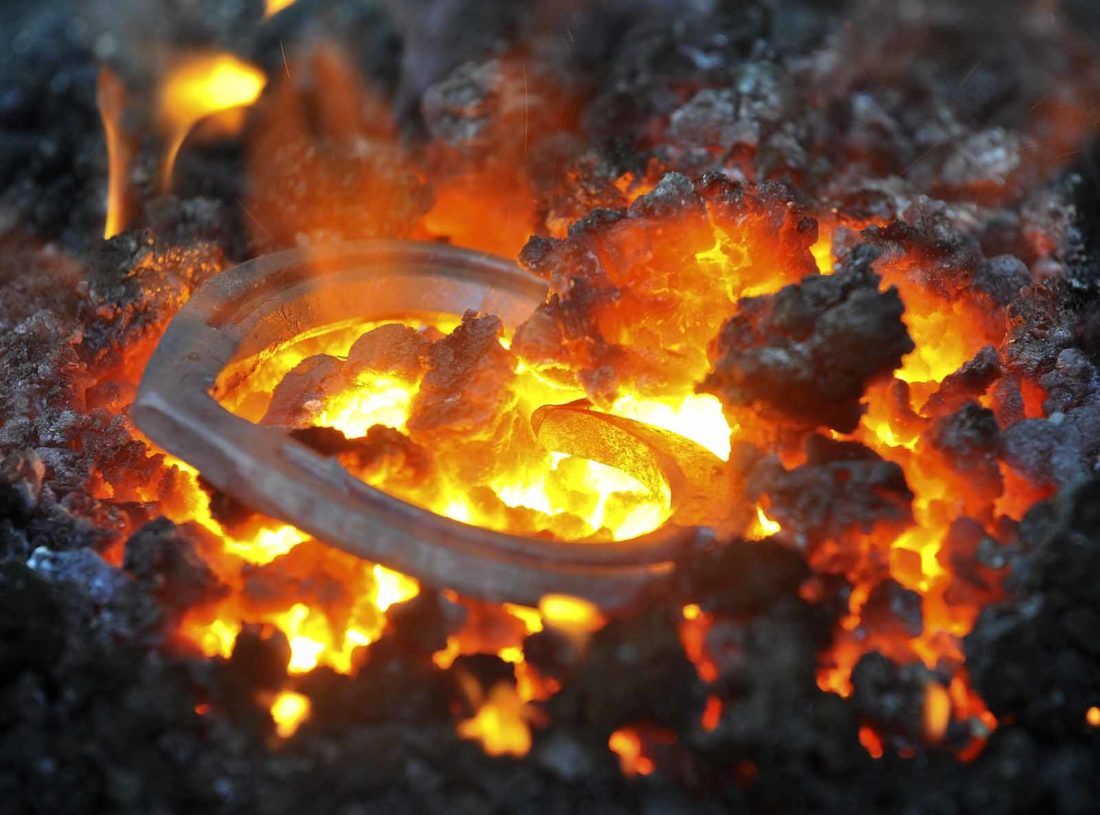
-Messenger photo by Hans Madsen
As the heart Ty Murray, of Stratford is working on nears completion he carefully heats the top section in his forge to complete joining the two halves. Making a heart from a horseshoe requires several heating, bending and hammering steps to complete.
“Every time I light the forge, I’m learning some way to do it easier, faster.”
Murray doesn’t just randomly heat a piece of steel, then start beating on it with a hammer. Every piece he makes is a carefully thought out and planned series of heating, drawing and bending steps.
“I have to plan a lot out,” he said. “I design it, make sure it’s laid out right. I’ve got a vision, but I can’t visualize.”
Sometimes even the best plans don’t work.
“It goes sideways sometimes,” he said. “It’s not the way you want it.”
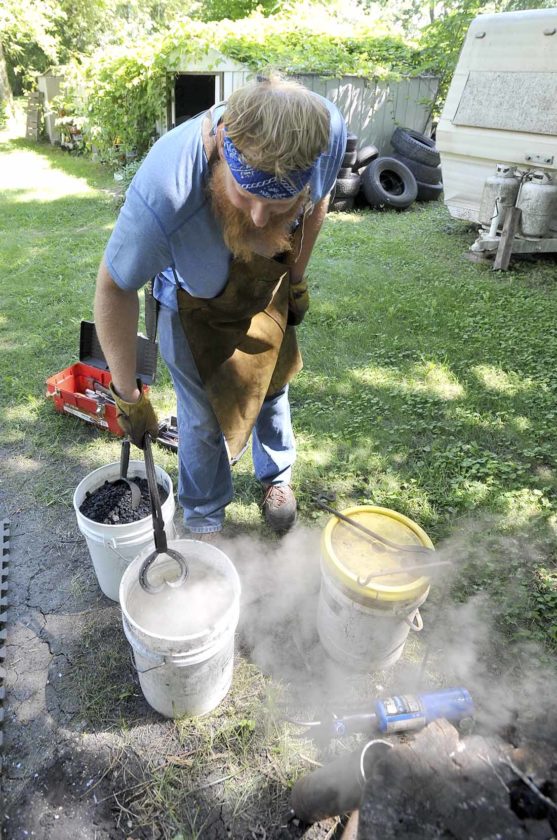
-Messenger photo by Hans Madsen
At the completion of the heating, bending and hammering work, Ty Murray quenches the now fully formed horseshoe heart in a bucket of water. The heart still has to be polished, clear coated and a ribbon to hang it up, woven through the nail holes by his partner Darcy Runestad.
Many things can go wrong. Too much heat and the steel will melt. Too little, it’s hard to work. A hammer blow in the wrong spot can send it back to the forge.
Late in the working process, it can mean disaster and starting over.
“It was a sad day,” he said of one ruined piece. “I threw it over there.”
Working on a piece is a combination of art, science and experience. The heat has to be just right and in the right spot. The right tool for the next step has to be ready and in hand. The blacksmith has to think ahead.
“It’s like playing chess,” he said. “You need to know what to do when you pull it out of the fire.”
Runestad also works at the forge with Murray, in addition to being the artist who creates the ribbon work used to hang the piece for display.
“I do a little smithing,” she said.
She does most of her work on smaller pieces of steel, mostly using various pliers to twist and bend the steel into shape. Not all blacksmith work is done with hammers.
They take advantage of their time working together.
“We do a lot of brainstorming on projects,” she said. “We talk about what to make and how.”
It’s also quality couple time for the pair, they said.
For those who might be interested in taking up the art, Murray warns that it can be an expensive process to acquire the equipment. He’s grateful that he has his father’s forge and anvil. He had to buy his own tools, though.
“Dad won’t give those up,” he said.
They’re also glad that interest in blacksmith work is seeing a resurgence.
“It’s good the interest is coming back,” she said.
That’s the good news.
The bad news is the impression of the art given by TV shows where skilled blacksmiths compete against the clock and each other to make an object, usually something complicated and difficult.
“It’s not a very accurate representation of what goes into it,” she said. “You see people that are really talented fail. It makes it appear that they don’t know what they’re doing. It can ruin a reputation.”
Murray and Runestad sell a variety of home decor, yard art and even jewelry items. They attend a lot of local events, such as the Webster County Fair and the annual Dayton Expo.
They also have their items available online.
They both attend those events where they can meet people and socialize.
Murray particularly enjoys demonstrating his art for children.
“Kids don’t get a chance to see this,” he said. “When you pull a big piece of red hot metal out, their eyes get huge when they see that flowing like Playdoh.”
Pricing the work can be difficult. The buyer is paying an artist for his time. To produce a leaf-shaped key chain requires 200 to 300 hammer blows.
“It’s a $10 item, but there’s a whole lot of work in it.” he said.
Each piece is wire brushed, clear coated, and then Runestad weaves the ribbon into it in the customer’s favorite color.
“You’re paying for the time,” he said. “There’s a lot that goes into it that people don’t see.”

